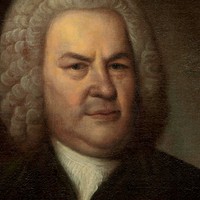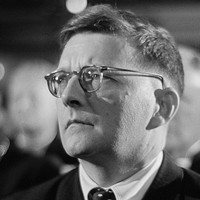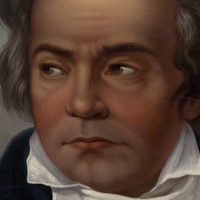Details
 Watch Video
Watch Video
Johann Sebastian Bach
Chromatic Fantasy and Fugue

Dmitri Shostakovich arr. Rudolf Barshai
Chamber Symphony in F for Strings and Winds
The Third String Quartet of Shostakovich shares the neo-Classical bent of his Ninth Symphony, composed a year earlier. The balanced, Mozartean phrases of their opening movements sound as odd as can be for music emerging from the ruins of World War II, when Soviet artists of the era were on the steps of another round of bureaucratic abuse. The string quartet shares a few other traits with the symphony, including a doleful movement and another cast as an unhinged dance. They both have five movements, which Shostakovich’s son Maxim claimed was reserved for his “greatest and most serious compositions.”
Shostakovich completed the string quartet in August 1946, at his state-supplied dacha in Komarova, a small town that was a popular spot for summer vacations. It starts with a carefree, jaunty theme, which gives way to a darker melody that wanders seemingly aimlessly before being sliced off midstream. The quartet largely keeps with Classical-era formality, ending with a properly strong cadence. The second movement opens up new territory with a motorically rising accompaniment, providing support for a jagged melody. Shostakovich’s tone is stern and angry, but the sort of anger that keeps its actions in check.
The third movement boils over with slashing chords at the outset, followed by one of Shostakovich’s macabre minor-key dances. The fourth is a series of mournful passages, each with its own melancholy sound. Mystery pervades the final movement, as the searching melodies pass around each other slowly. The mystery isn’t dispelled by the end, as a high violin drifts away, far above a placid accompaniment. According to the violist who gave the quartet’s premiere, the Beethoven Quartet’s Fyodor Druzhinin, this quartet led to one of Shostakovich’s rare public displays of emotion for his own music: “When we finished playing, he sat quite still in silence like a wounded bird, tears streaming down his face.”
Rudolf Barshai has been a lifelong proponent of Shostakovich’s music, first as his composition student; later as a violist in the Borodin Quartet, which premiered several of Shostakovich’s string quartets; and then as a conductor. Barshai led the first performance of Shostakovich’s Eleventh Symphony in 1960 and recorded all of Shostakovich’s symphonies with the Cologne Radio Orchestra. He’s orchestrated several of Shostakovich’s quartets, and the winds, harp and timpani he added to the Third are fully in keeping with the composer’s intent. The lonely flute heard prominently in the middle of the second movement was a favorite Shostakovichian sound and the bassoon at the end of the fourth movement echoes a similar bassoon solo from the Ninth Symphony, heard just one year before. Sadly, political machinations in 1948 would cause much of Shostakovich’s music to be pulled from circulation.
Marc Geelhoed ©2010
 Watch Video
Watch Video
Ludwig van Beethoven
Piano Concerto No. 4
On December 22, 1808, Beethoven presented a remarkable concert in Vienna. The four-hour extravaganza featured the public debuts of the Fifth and Sixth Symphonies, the Fourth Piano Concerto and the Choral Fantasy (composed as a showstopper for the occasion), as well as miscellaneous excerpts from the Mass in C, a rendition of the concert aria Ah! Perfido and some piano improvisations. Reports from the concert bemoaned the glut of music, the hall’s frigid temperature and a sloppy orchestra; the Choral Fantasy actually ground to a complete halt, at which point Beethoven returned to the beginning and prolonged the concert even further.
The Fourth Piano Concerto left spectators particularly baffled, and the work remained largely untouched until Felix Mendelssohn revived it in 1836. The mystery begins when the piano enters alone, spinning out a simple harmonic progression marked piano dolce (quiet and sweet). Then, after the piano leaves a chord hanging that by all expectations would resolve back to a stable point of arrival, the soloist withdraws and the strings enter in a totally foreign and exotic new key. Unexpected harmonic transitions continue to crop up throughout the first movement, keeping with the quizzical mood established at the outset.
In the central Andante con moto, a single line, scored across several octaves in the strings, engages the piano in a halting tête-à-tête in E minor. The final cadence flows directly to the Rondo finale, which again starts with just a whisper. The strings take the lingering memory of the pitch E as the start of the galloping tune, stating the theme first and then passing it to the piano. The melody begins with a repeated tone and an ascending arpeggio that anchors our ears in C major—except the actual destination of this concerto is to return to its starting key of G major. Amazingly, this main theme of the finale never begins in the “proper” key, even when it appears moments from the end, adding to the sense of sleight-of-hand that defines this most elusive of Beethoven’s piano concertos.
— © Aaron Grad
Aaron Grad ©2017
About This Program
Pianist Jeremy Denk joins the SPCO fora performance beginning with selected preludes and fugues for solo piano by Bach. This concert also includes a chamber orchestra arrangement of Shostakovich’s Third String Quartet, written under intense scrutiny of Communist censorship. The concert concludes with one of the core works in piano concerto literature, Beethoven’s Fourth Piano Concerto.
The March 24 evening concert is currently sold out. Click the wait list link above to be added to a free waiting list. You will be contacted if tickets become available.

